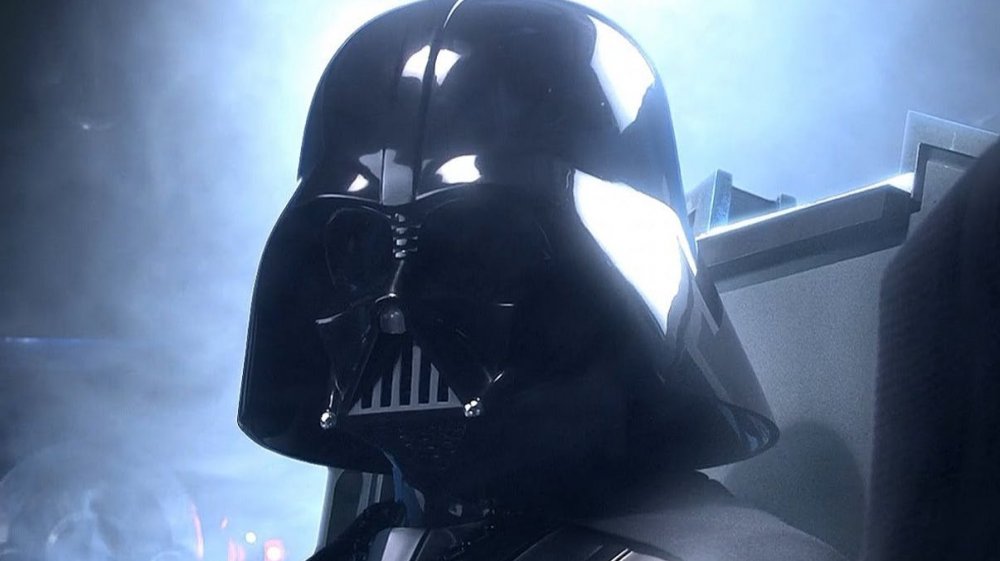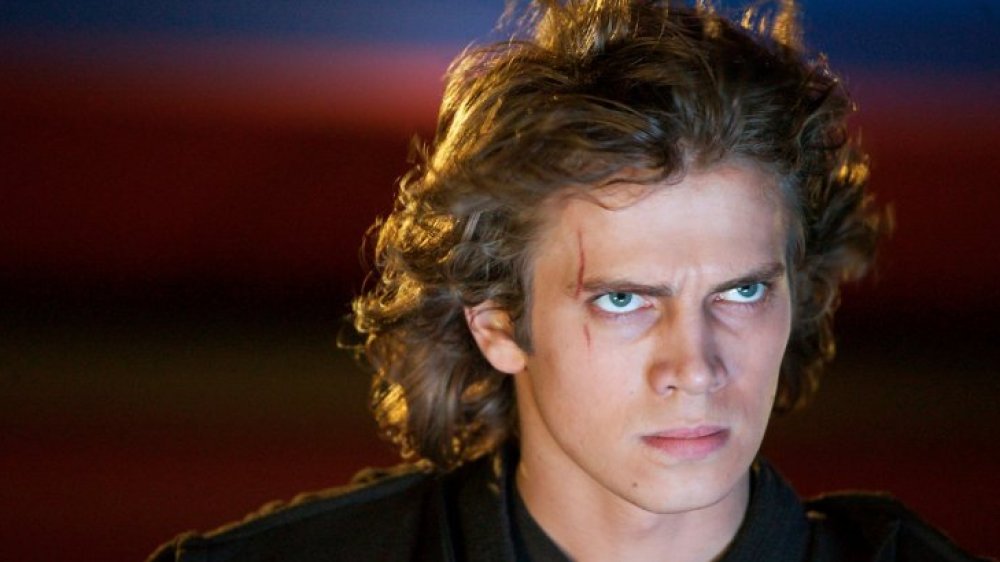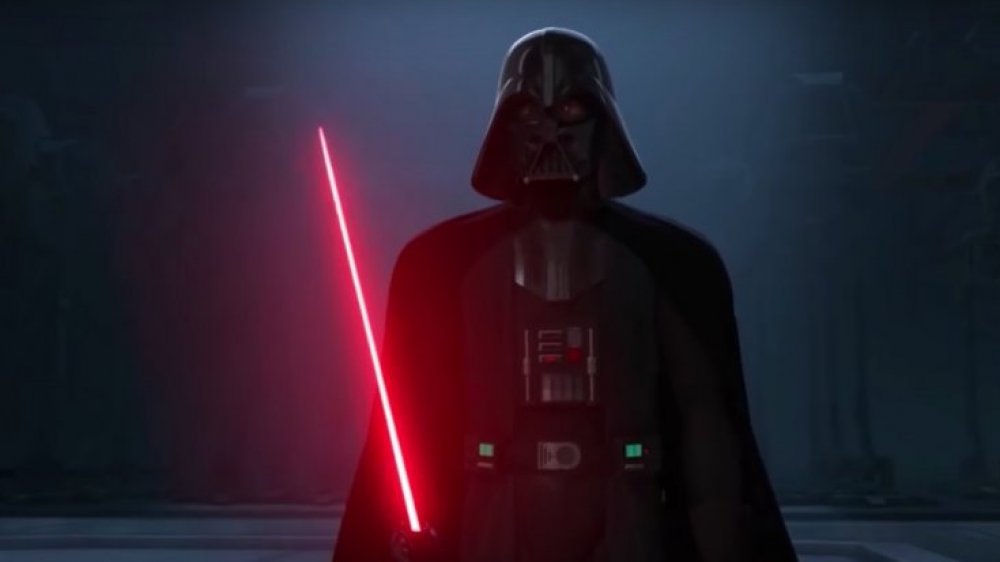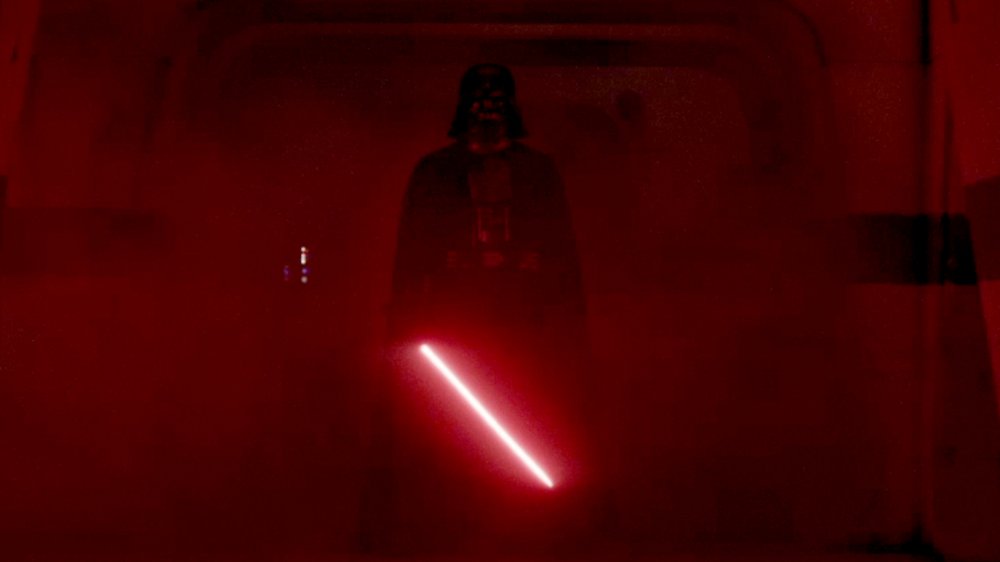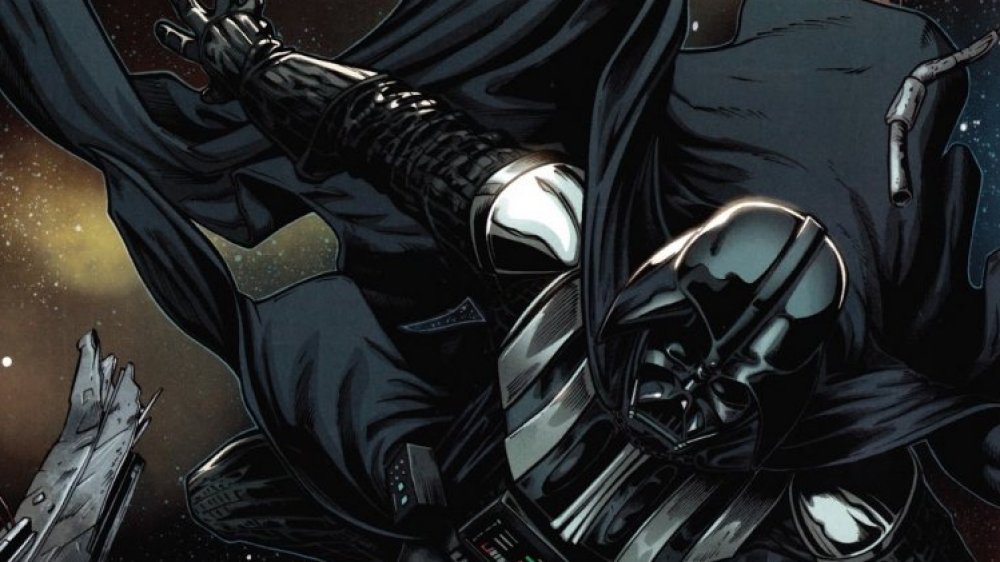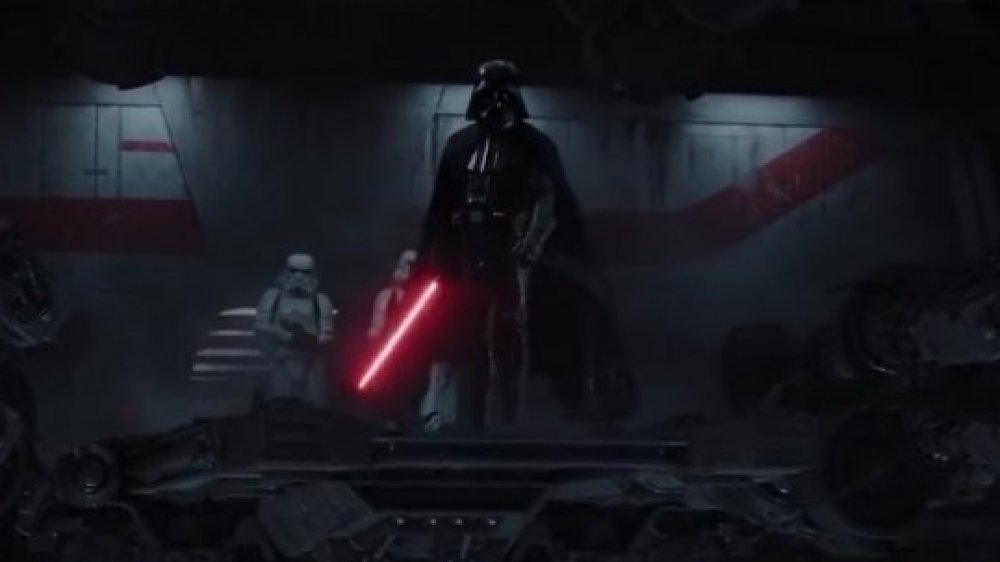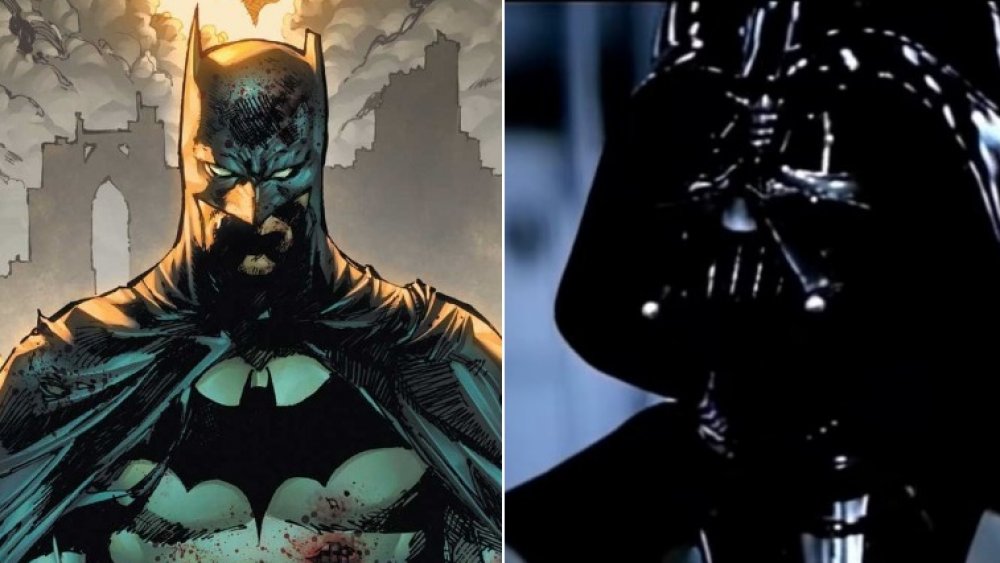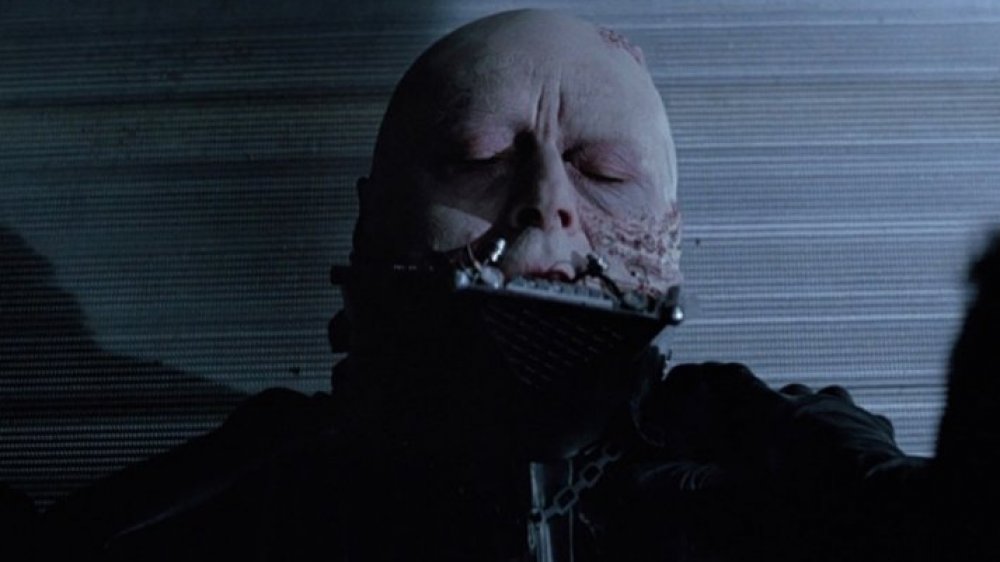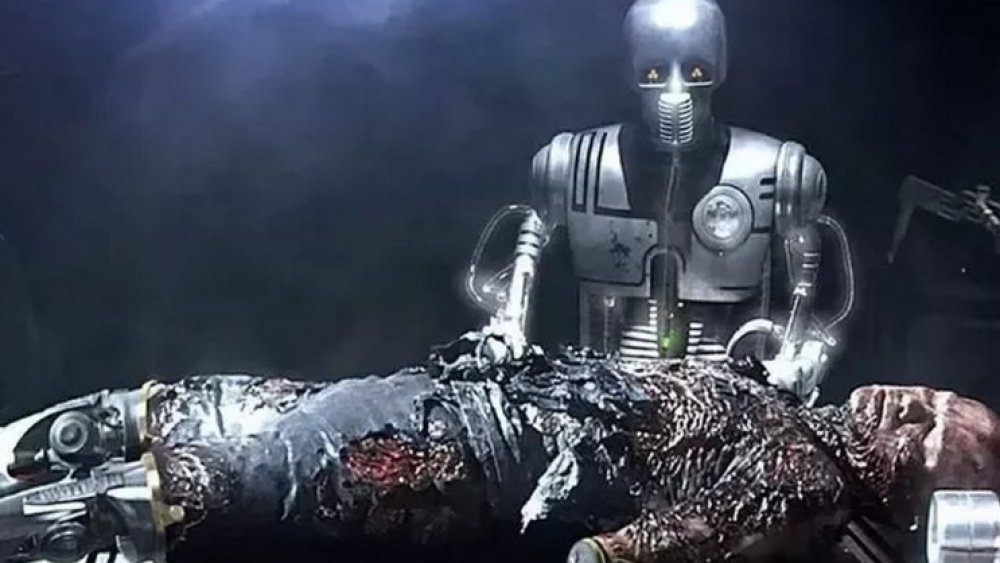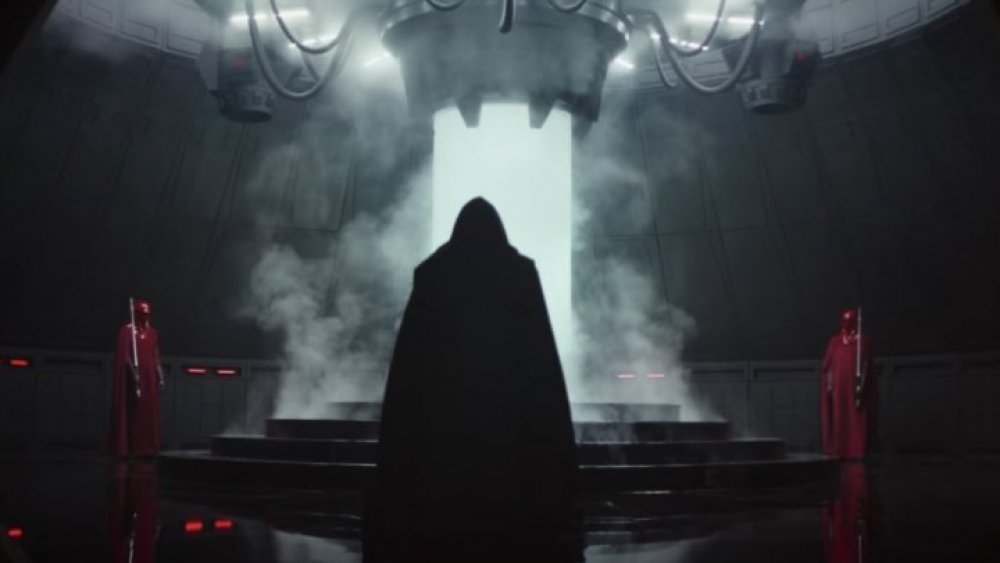Secrets Of Darth Vader's Armor
In 1977, Star Wars (later subtitled A New Hope) introduced some intriguing concepts to viewers, from the invisible magic of the Force that dwells within everyone to the mysterious desert-dwelling wizard Obi-Wan Kenobi. But while viewers might have been impressed and amused by space magic and laser swords, there's nothing amusing about the indomitable visage of Darth Vader. Clad in black armor and a regal cape, sporting a helmet with massive bug-like eyes, his intimidating visage is topped off with a raspy ventilator that strikes fear into the hearts of his enemies and his own troops alike. From helmeted head to padded feet, nearly everything about this Dark Lord of the Sith is meant to elicit fear.
Right from the beginning, Star Wars beautifully established a world that feels lived in, where everyone and everything has a story, regardless of whether you know it or not. Unsurprisingly, there's more to Darth Vader's armor than meets the eye. Here are the hidden origins of the Sith Lord's armor.
Anakin Skywalker needs the suit to live
In the Star Wars prequel trilogy, fans learn the tragic story of Anakin Skywalker. Born with no father to a slave named Shmi in the unassuming desert wastes of Tatooine, Anakin shows a powerful bond with the Force from an early age. The child is so powerful that Jedi Master Qui-Gon Jinn theorizes upon meeting him that Anakin was conceived by a pure distillation of Midichlorians (the scientific explanation for the Force). Beyond causing long-time Star Wars fans to tear their hair out at the idea that their favorite quasi-mystical spiritual concept could really be boiled down to invisible particles in the air, this also means that Anakin is seemingly destined for greatness as a Jedi.
As Anakin ages, he doesn't necessarily mature in proportion, letting his emotions control him in direct defiance of Jedi teachings. While both his master Obi-Wan and his friend-turned-lover-turned-wife Padme try to keep his anger from flaring up, it's encouraged by Supreme Chancellor Palpatine in an attempt to groom Anakin into his Sith apprentice. Tensions come to a head during the events of Revenge of the Sith, as Obi-Wan and Anakin come to blows, leaving Anakin scarred, burned, and close to death on the fiery surface of the planet Mustafar.
He's saved by Palpatine's medical droids, though not before enduring massive amounts of pain and suffering, leaving him three fewer limbs than he started with. The imposing black-clad armor that creates such a striking visual in the movies is actually a mechanic mobile life support system that allows him to stay living after such a traumatic event.
While Anakin dies, Darth Vader lives
Because of the damage from Obi-Wan's lightsaber (not to mention the fiery surface of Mustafar), Anakin becomes, in the words of Obi-Wan in A New Hope, "more machine now than man — twisted and evil." The iconic chest plate on Vader's chest regulates the life-saving properties of the suit, with each colored button corresponding to a different regulation to mimic a healthy body. According to the book Star Wars: The New Essential Guide to Weapons and Technology, the various buttons control everything from CO2 exhaust vents to exacting temperature controls so as not to irritate Vader's horribly burned skin. Even his movement within the suit is controlled by electrical probes, snapping his nerves to attention despite the damage that he suffered while battling Obi-Wan.
While his armor might keep him mobile and (relatively) healthy, it is Vader's helmet that keeps him alive. The mask regulates Vader's breathing, even through lungs and a throat so horrifically scarred that they're not capable of recognizing oxygen. The helmet is also outfitted with needles that interface through his cranium, letting the suit regulate the entire mechanical pulmonary and respiratory system. The entire system records its own functions, since such a finely-tuned machine needs to be kept in tip-top shape lest it leaves the Dark Lord of the Sith as helpless as a stalled-out 74-Z Speeder Bike in Sand People territory.
The armor changed Vader's fighting style
Viewers watching the prequel trilogy and The Clone Wars television show might have been surprised to see how high-flying Anakin's fighting style was compared to the dense, indomitable style he would later adopt as Darth Vader. In the prequel trilogy, Anakin fights like an acrobat, letting his natural Force affinity propel him like a fighting dynamo, jumping and dashing around his opponents. But when he's beaten by Obi-Wan, he loses three of his original limbs, finally bringing the high-flying Anakin down to earth.
When he's reconstructed into Darth Vader, the weight of the armor and assorted machinery make it incredibly difficult to raise his lightsaber above his head. Even with the assistance of the Force, Vader's movement is much more like a powerful tank than the quick fighter jet that he used to be. The climax of Rogue One: A Star Wars Story is a perfect example, as Darth Vader steadily marches down a corridor, using his Force powers and reflecting blaster bolts to cover for his slow walking speed.
With the loss of his speed, Vader gained a technological advantage
While Vader needs his heavy armor to live and move normally, the cutting-edge technology used in his armor also allows for powerful techniques that even a classically-trained Jedi would have trouble matching. Vader's boots have powerful gravitational pull due to a ferromagnetic core in the heel, allowing him to stick to spaceship hulls even in the vacuum of space, as seen in the comic series Darth Vader and the Ninth Assassin.
Even more impressively, the suit itself is completely airtight, giving Vader a nigh-unmatched ability to attack from any direction. Slow, unstoppable, and more machine than man, it's hard not to see Darth Vader as an influence on the unstoppable cyborg of James Cameron's Terminator franchise. Even the boots themselves are made with the same high-tech insulation and protection as the rest of his armor, making it impossible to sweep the leg.
Vader's armor itself is incredibly dense
Speaking of incredibly dense armor, Vader's defense doesn't stop at his feet. His suit, insulated with over ten distinct layers thick enough to survive the vacuum of space, makes him nearly impervious to most forms of damage. Each layer of the armor is made of a different material, from an improved version of the Reifflex cellular padding that's used in stormtrooper helmets to orthofabric and mylar laminate, and even a polychlorophene-2 fiber weave.
Each layer of the suit serves a different purpose, from making sure that it remains fireproof (a logical idea, considering the damage that fire has caused to Vader in the past) to extra padding in the chest to guard against impacts, so that sudden shocks don't cause internal bleeding or organ damage. Even the cape that Vader wears is made up of a strong, lightweight armorweave to give extra protection from surprise attacks from behind, even as the cape itself defends the various air vents from clogging.
Vader is more similar to Batman than you might think
An intimidating, deep-voiced man that's become legendary for his commitment to establishing order. The sight of his black cape and mask strikes fear in everyone who sees him. Deep, deep family issues. Quick — who are we talking about, Batman or Darth Vader? Despite the fact that they would no doubt be archenemies in a cross-over, the Dark Knight of Gotham and the Dark Lord of the Sith have more than a little in common.
Even beyond the aesthetic similarities (a natural result of both characters being somewhat inspired by Dracula), both characters have powerful gauntlets that they use to block the swords of their enemies. In Darth Vader's case, the gauntlets are made from a micronized Mandalorian iron weave, giving him both superhuman strength in his cybernetic fists and a backup defense to block lasers and blades when his lightsaber proves insufficient.
His mask connects him further to the force
The powers that Vader gains from his cybernetic suit aren't just limited to strength and toughness, however. His iconic helmet is constantly feeding him data on nearby environmental hazards, along with operational data that better connects him to his Force senses. By giving him advance warning of possible explosions and other dangers, it minimizes the chance of the suit being damaged by an accidental explosion or stray blaster shot.
Even the bug-eyes of his helmet serve a nefarious purpose. They serve as a technological replacement for his damaged eyes, allowing him to see further along the visible spectrum than most humans, even in total darkness. The lenses expand and contract Vader's eyesight at various times to protect his vision, acting like a futuristic version of transition lenses. Considering how often Darth Vader is seen walking through bursts of sparks and blaster bolt fire, they can likely transition extremely quickly.
All that power comes with a price
While the helmet's powerful lenses and computer calculations allow Vader to be even more of a nocturnal predator than the legends about him might say, all that power comes with a price. The helmet itself has to be bolted to his head, both through the micro-needles that connect his brain to the computer, and through larger, stronger bolts that connect the helmet to his skull. More than just defensive armor, Darth Vader literally needs his helmet and suit in order to stay mobile.
Beyond the constant discomfort that the bolts and needles would cause, the difficulty of removing it all requires Vader to consume nearly all his food through intravenous circulation, or by drinking paste through a straw. Even breathing through the mask is such a challenge that Vader can almost never rest or fully sleep while wearing the helmet. In other words, nearly every moment of his life is suffused by an active discomfort and pain. But it gets worse...
Inside the armor, his skin remains damaged
Even inside the armor, Vader's burned skin remains horrifically mutilated. The constant itching and nerve damage necessitates that Vader consume nerve-dulling agents, and he needs to be sanitized regularly before he becomes consumed by necrotic tissue. The mechanical enhancements don't always sync perfectly with his unconscious movements, requiring pinpoint focus and surreptitious use of the Force at various times, according to Star Wars: The Rise of Darth Vader.
In short, the suit serves as a constant barrier against his inevitable death, a death which would come quickly the moment the suit was disabled in any sizable way. His reliance on the suit's power to keep him alive is why his death in Return of the Jedi came so quickly after his armor was disabled by the Emperor's Force Lightning. When the Lightning shorted out the various safeguards keeping him alive, there was nothing left to keep Vader from succumbing to the death he'd delayed for so long.
The Meditation Chambers
The only refuge Vader has from his wearable metal coffin comes from the meditation chambers scattered across various worlds, as well as on his Star Dreadnought Executor. In these meditation chambers, Vader can remove his mask and rest somewhat peacefully without the constant threat of claustrophobia that threatens him while wearing the armor. Even then, his paranoia is so strong that he only allows machines to assist him in removing his mask.
Notably shown in Rogue One was his castle on Mustafar, the same planet where he dueled Obi-Wan. Within the castle, Vader has a Bacta Tank, where he can submerge himself fully in healing fluid, free from both his mask and his suit. Only then, protected by his royal guards and the machines that keep him alive, can Darth Vader truly rest — at least until the Emperor calls for him to serve once again. As they say, there's no rest for the wicked.
